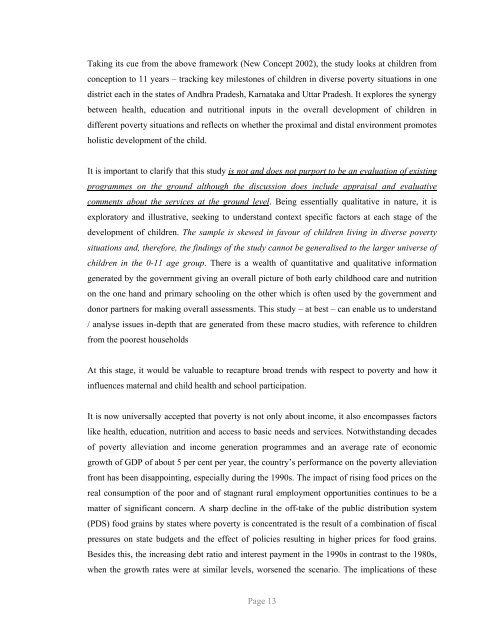Snakes and Ladders - ERU Consultants Pvt. Ltd.
Snakes and Ladders - ERU Consultants Pvt. Ltd.
Snakes and Ladders - ERU Consultants Pvt. Ltd.
Create successful ePaper yourself
Turn your PDF publications into a flip-book with our unique Google optimized e-Paper software.
Taking its cue from the above framework (New Concept 2002), the study looks at children from<br />
conception to 11 years – tracking key milestones of children in diverse poverty situations in one<br />
district each in the states of Andhra Pradesh, Karnataka <strong>and</strong> Uttar Pradesh. It explores the synergy<br />
between health, education <strong>and</strong> nutritional inputs in the overall development of children in<br />
different poverty situations <strong>and</strong> reflects on whether the proximal <strong>and</strong> distal environment promotes<br />
holistic development of the child.<br />
It is important to clarify that this study is not <strong>and</strong> does not purport to be an evaluation of existing<br />
programmes on the ground although the discussion does include appraisal <strong>and</strong> evaluative<br />
comments about the services at the ground level. Being essentially qualitative in nature, it is<br />
exploratory <strong>and</strong> illustrative, seeking to underst<strong>and</strong> context specific factors at each stage of the<br />
development of children. The sample is skewed in favour of children living in diverse poverty<br />
situations <strong>and</strong>, therefore, the findings of the study cannot be generalised to the larger universe of<br />
children in the 0-11 age group. There is a wealth of quantitative <strong>and</strong> qualitative information<br />
generated by the government giving an overall picture of both early childhood care <strong>and</strong> nutrition<br />
on the one h<strong>and</strong> <strong>and</strong> primary schooling on the other which is often used by the government <strong>and</strong><br />
donor partners for making overall assessments. This study – at best – can enable us to underst<strong>and</strong><br />
/ analyse issues in-depth that are generated from these macro studies, with reference to children<br />
from the poorest households<br />
At this stage, it would be valuable to recapture broad trends with respect to poverty <strong>and</strong> how it<br />
influences maternal <strong>and</strong> child health <strong>and</strong> school participation.<br />
It is now universally accepted that poverty is not only about income, it also encompasses factors<br />
like health, education, nutrition <strong>and</strong> access to basic needs <strong>and</strong> services. Notwithst<strong>and</strong>ing decades<br />
of poverty alleviation <strong>and</strong> income generation programmes <strong>and</strong> an average rate of economic<br />
growth of GDP of about 5 per cent per year, the country’s performance on the poverty alleviation<br />
front has been disappointing, especially during the 1990s. The impact of rising food prices on the<br />
real consumption of the poor <strong>and</strong> of stagnant rural employment opportunities continues to be a<br />
matter of significant concern. A sharp decline in the off-take of the public distribution system<br />
(PDS) food grains by states where poverty is concentrated is the result of a combination of fiscal<br />
pressures on state budgets <strong>and</strong> the effect of policies resulting in higher prices for food grains.<br />
Besides this, the increasing debt ratio <strong>and</strong> interest payment in the 1990s in contrast to the 1980s,<br />
when the growth rates were at similar levels, worsened the scenario. The implications of these<br />
Page 13












